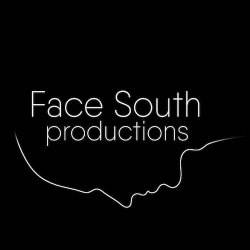One dreary Wednesday afternoon your special correspondent braved the drizzle and headed to “The Shack” otherwise known as Charles’s trailer-classroom back behind the school, where Tommy Burruss and Casey Robertson were hard at work editing their documentary about the Lady Dolphins.
“The lights are only on cause we knew you were coming,” says Tommy after introductions. Tommy and Casey have been sitting here in the dark editing well over 90 hours of footage into a what will presumably be less than a two hour finished product.
“Usually you would take all this footage and make a script around it, but we’re bypassing that step...It’s a big block of wood—we’re gonna take a saw to it and see where it lands.” Tommy speaks with highly animated enthusiasm, and seems stoked to share some of their process with me.
If you’ve seen a big dark-grey van around with “Face South” painted on the side, you might be wondering what that’s about—I certainly was. Face South Productions is an LLC that Tommy created to support this current project, and the name came from wanting to have a compass rose, (“I come from a very nautical family”) with South as the reference instead of North, “Then Casey came up with this logo, and I was like ‘this is genius!’”

“Everybody’s pretty used to me having a camera, I'm always shooting something,” Tommy says, and so Coach B. asked him to cover the girls basketball team for a couple of games. One thing led to another and Tommy wound up spending the winter here following the Lady Dolphins all over the state, collecting interviews, and sifting through the story.
“We got the information for a good story—was I able to capture it? We’ll see.”
“Every good sports movie has some social issue at it’s core,” says Tommy, “I knew immigration was going to be part of this story—two cultures coming together in a symbiotic way with basketball.” But when he started work on the documentary he recalls that everyone was pretty hopeful about Hillary Clinton, and that the Latino population of Ocracoke was relaxed.

Despite the adversity—or perhaps partly because of it—making the documentary was a fun and exciting challenge. “It's a bit of a learning curve,” says Tommy, but, “I like it, it’s fun, it’s easy!” The biggest challenge he faced was a lack of manpower, “There were three of us over a season, usually you’d have twenty people every day.” This means that he still doesn’t know if he’s covered everything he wanted to, especially since he sometimes got so invested in the games he forgot to turn on the camera—“luckily we had backups—GoPros and things like that.”
In addition of course, he faced the same sort of grueling travel-hours as the team did, but that was part of the fun. When asked what his favorite part of the experience was Tommy says, “The girls, hands down, I feel being a part of that community and them taking to me like I took to them. Hanging with the team—getting caught up in the game!”
As for the filming itself he says that the girls never lost an awareness of the camera, a phenomenon he attributes to social media—“Ten years ago if I had been doing this, after a day they would have forgotten that the camera was there, but these girls have had cameras pointed at them all their lives—not film cameras, but you know Snapchat.”
“I told them we’re not making reality TV here, I don’t care who you’re dating...unless it starts to affect gameplay, then maybe we’re interested.”
“I love Ocracoke, I love Burleson, he’s amazing—the movie becomes more about him than anyone else—and well it should, he’s the one who got it started.”

Casey, who has been learning editing whilst editing the film calls it an interesting, unique, challenge. “It’s fun learning new skills,” he says. Casey was initially brought on the team because Tommy saw some of his gorgeous time-lapse shots and wanted to know if he could use them for the documentary.
Next up Tommy has aspirations to make a film about the fishing tradition on Ocracoke (“This place is so cinematic.”), and he believes that we are at the perfect crossroads now of technology and tradition to capture a fading culture. “With drones and other technological advancements we can really cover the act of fishing in a way no one’s done,” he says.
Before I leave Tommy shows me some of the footage that they’re working on this week, a clip from the Latino Festival last fall and a clip of the team’s first practice. As we watch Tommy runs a constant commentary on the people, events, and shots from the clips. “That’s my favorite shot in the whole movie! So David Lynch—so Coen Brothers!” His enthusiasm is infectious and indeed the film looks great, both visually and thematically.
When asked for a closing remark he says, “I keep telling them, we’re the good guys here—the world, adversity, ferries not running, refs cancelling, busses—all that’s out there, but we’re the good guys.”
Watch the trailer for the Lady Dolphins movie on Facebook here!
